AASIMARS
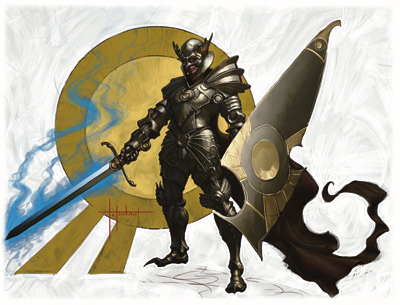
Carrying the blood of a celestial, an aasimar is usually good-aligned and fights against evil in the world. Some aasimars have a minor physical trait suggesting their heritage, such as silver hair, golden eyes, or an unnaturally intense stare.
Personality: Most aasimars strive for nobility in their behavior, but must often fight against tendencies toward vengefulness or quick judgment. Some also experience a great deal of prejudice, particularly from their human neighbors, which can lead to aloofness. Ultimately, most aasimars tend to be loners, unable to fully trust others.
Physical Description: Aasimars look human (and are roughly the same height and weight as members of that race), except for one distinguishing feature related to their unusual ancestry. This feature may take the form of silver hair, golden or even topaz eyes, iridescent skin, an intense stare, or a powerful, ringing voice. Aasimars reach adulthood at about the same age as humans but are longer-lived, with the eldest members of the race living to be 150 years old.
Relations: Although aasimars are mostly human, they rarely feel like they fit in among human society. Instead, they get along best with other halfbreeds - namely, half-elves and half-orcs - because they usually share the same sort of semioutcast background. Good-aligned aasimars are also generally friendly toward bariaurs and wildren, which share some of their celestial heritage. Of the other races, aasimars save their distrust for tieflings, whose fiendish ancestry strikes a chord of suspicion in the heart of the aasimar.
Alignment: Aasimars are usually good, as befits their celestial heritage. However, the extraordinarily rare evil aasimar often makes the vilest villain.
Religion: Aasimars have no chief deity. Popular choices among aasimars include Heironeous, god of valor; Pelor, god of the sun; and Kord, god of strength. Those with a more judgmental outlook may venerate St. Cuthbert of the Cudgel.
Language: Aasimars have no cultural language, although those that realize their heritage usually learn Celestial. An aasimar usually learns the language of her parents.
Names: Aasimars generally take human names, though some change their names upon reaching young adulthood and realizing their heritage.
Adventurers: Aasimars make natural adventurers; their burning desire to battle evil easily draws them into such a life. Many pursue a divine calling, becoming paladins or clerics, but the race also boasts many powerful sorcerers, bards, fighters, and rangers.
AASIMAR RACIAL TRAITS
-
+2 Wisdom, +2 Charisma.
-
Outsider (Native): Aasimars are outsiders native to the Material Plane, and thus have the outsider (native) type. They gain the extraplanar subtype when not on the Material Plane. They are not subject to spells or effects that affect only humanoids, such as charm person and dominate person.
-
Medium: As Medium creatures, aasimars have no special bonuses or penalties due to their size.
-
An aasimar's base land speed is 30 feet.
-
Aasimars have darkvision out to 60 feet.
-
Skills: Aasimars have a +2 racial bonus on Spot and Listen checks. They are naturally alert and attentive.
-
Daylight (Sp): An aasimar can use daylight, as the spell, once per day. His caster level is equal to his character level.
-
Resistance to acid 5, cold 5, and electricity 5: Aasimars share some of their celestial ancestors' resistance to energy damage.
-
Automatic Languages: Common, Celestial. Bonus Languages: Draconic, Dwarven, Elven, Gnome, Halfling, Sylvan.
-
Favored Class: Paladin. Inherently noble, many aasimars follow the calling of paladinhood.
-
Level Adjustment: +1.
BARIAURS
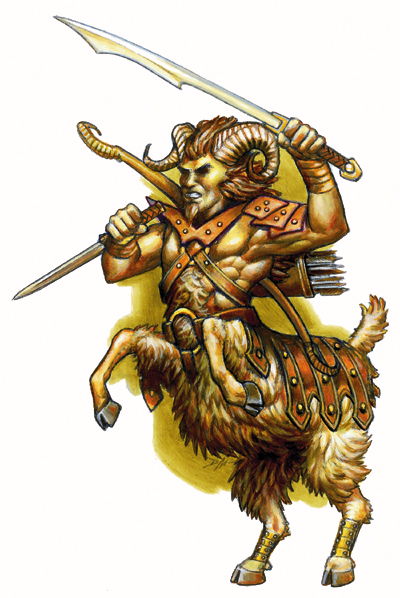
Native to the rolling hills and woods of Ysgard, the centaurlike bariaurs wander the lands in search of evil. When a vile foe is located, the bariaurs charge into glorious battle.
Personality: To those unfamiliar with them, bariaurs appear carefree or even irresponsible, but this behavior is merely the outward sign of their wanderlust. They rarely remain in one place for long, preferring a life of travel to sedentary existence. When evil rears its ugly head, this carefree demeanor disappears, replaced by single-minded pursuit of that which endangers good folk of the area.
Physical Description: Standing roughly half a foot taller than a human, a bariaur resembles a centaur. Its lower body is that of a ram, with sleek brown or golden fur and cloven hooves. Its upper body is humanlike, powerfully muscled and sporting a pair of ramlike horns atop its head. The skin of a bariaur ranges in color from pale tan to deep nut-brown. The typical male weighs nearly 300 pounds, with females about 40 pounds lighter. The average bariaur reaches adulthood at about the same age as a half-elf, and the eldest members of the race live to well over 200 years of age.
Relations: Bariaurs are social and outgoing, though not foolishly trusting. They get along well with elves, gnomes, half lings, and wil dren, as well as aasimars who aren't too strict in their outlook. They grudgingly accept dwarves as allies against evil. Halfbreeds, such as half-elves and half-orcs, are objects of curiosity to bariaurs. They are moderately suspicious of races with heritages tied to planes of evil or shadow, including tieflings and shadowswyfts, but they prefer to take a positive outlook about individuals until proven wrong.
Alignment: As creatures who value freedom, most bariaurs are chaotic good in alignment. Some more settled bariaurs tend toward neutrality in their approach to good, while a few stray from pure good toward neutrality. Evil bariaurs are extremely rare and always shunned from the flock.
Religion: Bariaurs revere Ehlonna, deity of the woodlands, more than most other deities. Some venerate Kord, god of strength, or Pelor, god of the sun.
Language: Bariaurs have no racial language, using Celestial for most conversations. They also speak Common to allow them to converse with other races.
Names: A bariaur's name is given to him by his parents. It is usually a simple, one- or two-syllable name (the easier to be shouted across the hills of Ysgard). Within the flock, he denotes his parentage by adding "buck of" his father's name (or "doe of" the mother's name, if female); outside the flock, he relies instead on a flock name to indicate the extended family to which he belongs. Flock names typically describe the environments favored by the flock, and can change over time.
Male Names: Bex, Hul, Jek, Menok, Ril, Wyk.
Female Names: Daeth, Hysh, Saph, Tyth, Vash.
Flock Names: Cloverfield, Dalewatcher, Hillwalker, Woodstrider.
Adventurers: The bariaur's wanderlust makes him an ideal adventurer. Though leaving the flock can be a difficult decision, a young bariaur who seeks to take the fight to the evil creatures of the multiverse fits in well with most adventuring groups. Bariaurs frequently follow the path of the ranger, though bariaur fighters and barbarians are also common.
BARIAUR RACIAL TRAITS
-
+2 Strength, -2 Charisma: Bariaurs are powerful, but they have underdeveloped social skills.
-
Outsider (Extraplanar): Bariaurs are native to the Heroic Domains of Ysgard, and thus have the outsider type. They gain the extraplanar subtype when not on Ysgard. They are not subject to spells or effects that affect only humanoids, such as charm person and dominate person.
-
Medium: As Medium creatures, bariaurs have no special bonuses or penalties due to their size.
-
A bariaur's base land speed is 40 feet.
-
Bariaurs have darkvision out to 60 feet.
-
Quadruped: As quadrupeds, bariaurs have a +4 bonus on checks to resist bull rush and trip attacks. They have a carrying capacity 1-1/2 times greater than normal for their Strength. They must wear barding (usually made of studded leather) instead of normal armor and cannot wear boots designed for humanoids.
-
Powerful Charge: A charging bariaur can make a single ram attack that deals bludgeoning damage equal to 2d6 + 1-1/2 times the bariaur's Str modifier.
-
Spell Resistance: Bariaurs have spell resistance equal to 11 + class level.
-
+2 racial bonus on Will saves against spells and spelllike abilities.
-
Skills: Bariaurs have keen senses, giving them a +2 racial bonus on Listen and Spot checks.
-
Automatic Languages: Celestial, Common. Bonus Languages: Abyssal, Infernal. Bariaurs commonly learn the languages of fiendish creatures to better prepare themselves against such threats.
-
Favored Class: Ranger.
-
Level Adjustment: +1.
BUOMMANS
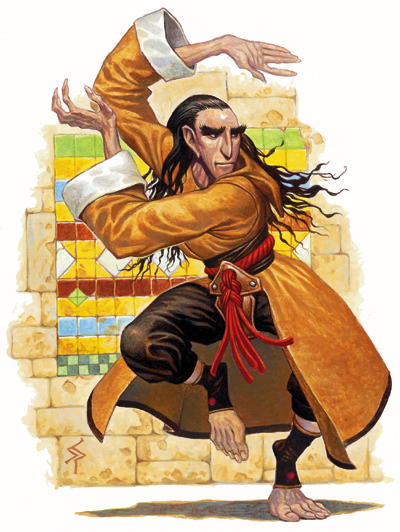
There might have been a time when the buommans were merely human visitors to the Astral Plane. But now, perhaps hundreds of millennia later, the buommans are neither merely visitors, nor merely human. Known to some astral denizens as the "moaning monks," buommans dwell in temples and shrines formed by astral debris, which they believe to be the mortal forms of sleeping deities, long forgotten. Whether the buommans inhabit these structures in the hope of awakening these deities, or in an effort to ensure that they stay asleep, is known only to the buommans.
Personality: Buommans are quiet, withdrawn, and deferential. Though they appear capable of understanding languages, they "speak" no tongue other than their low, booming songs in a dialect called Buommi, which appear to be more music than actual language.
Physical Description: Buommans appear more or less like humans, though with long, sagging faces and elongated hands and feet (a feature most prominent in the fingers and toes). On average, buomanns are slightly shorter and slightly heavier than humans. A male buomman has long hair and bushy brows; a female buomman has no apparent body hair. Buommans reach adulthood at about the same age as humans, and the eldest members of the race can live to be 120 years old.
Relations: Buommans often spend their entire lives in ascetic contemplation within the confines of the shrine or temple in which they were born. From time to time, though, a buomman (particularly a buomman monk) departs his or her home to explore the Astral Plane, or other planes, out of curiosity about the outside worlds. Sometimes these individuals gravitate to service with wandering githzerai, and occasionally venture back to Limbo with them. Buommans avoid confrontations with evil outsiders, more out of caution than from fear or dislike. If buommans have any enemies, they are most likely found on the planes of Pandemonium and the Abyss. Buommans get along quite well with creatures from the Elemental Plane of Earth or the Elemental Plane of Water.
Alignment: The average buomman is lawful, tending toward lawful neutral or lawful good. A few buommans are lawful evil or simply neutral.
Religion: Buommans eschew traditional religions, seeming, as they do, to worship their temple homes in the Astral Plane. A few who travel extensively develop an affinity for Fharlanghn, the god of roads. But few buommans become clerics of any deity, because their vow against speaking (described below) makes spellcasting difficult. Those who wish to learn to cast spells with verbal components must acquire the Nonverbal Spell feat.
Whether a buomman believes that the astral bodies that his race dwells upon are dead deities, sleeping deities to be awakened, or sleeping deities that must never rise is up to the individual buomman. Neutral buommans usually believe in the dead deities theory, while lawful good buommans believe that the deities are sleeping and will someday awake to spread their majesty again. Lawful evil buommans fear the return of these deities, and sing their songs to prevent them from awakening.
Language: Buommans communicate with one another by means of their low, throaty songs, but the concepts they convey appear to be more abstract than informational. Contrary to rumor, a buomman does not constantly sing, but instead sings as part of rituals that mark his daily life. The buommans have a song for arriving, a song for leaving, a song for waking, a song for sleeping, a song for eating, and countless other songs for far less concrete concepts. Except for these songs, buommans choose not to speak any recognizable language, though they are capable of learning any language they choose. The average buomman, for example, understands Common; he simply never speaks it.
Names: For a race that has collectively taken a vow against speaking, buommans have a wide variety of names - all of which are based on musical notes. For example, a buomman female might express her name as a short melody in the key of D sharp, and a different buomman female might express her name as the same melody, but in B sharp. The name of the race reflects this tradition, being based on the deep, sustained note that every buomman learns to vocalize before he or she can walk: "buomm."
For the convenience of other races, buommans do not mind accepting nicknames, but they prefer those that have no harsh consonants. "Jak," for example, would be an uncomfortable appellation, while "Moony" would suit a buomman just fine.
Adventurers: Most buommans who feel the urge to explore are younger members of the race. They usually set out with the goal of gathering information for the temple (which usually means seeing the multiverse), with the intent of returning to the ascetic life when they become tired or homesick. Some few actually do return, late in life, to introduce new concepts into their insular societies.
BUOMMAN RACIAL TRAITS
-
+2 Wisdom, -2 Charisma. Buommans have great insight and willpower, but their reserved nature leads to poor interpersonal skills.
-
Humanoid (Extraplanar): Buommans are humanoids native to the Astral Plane. They gain the extraplanar subtype when not on the Astral Plane.
-
Medium: As Medium creatures, buommans have no special bonuses or penalties due to their size.
-
A buomman's base land speed is 30 feet.
-
Low-Light Vision: A buomman can see twice as far as a human in starlight, moonlight, torchlight, and similar conditions of poor illumination. He retains the ability to distinguish color and detail under these conditions.
-
Skills: +2 racial bonus on Listen and Perform (sing) checks. All buommans have uncanny hearing and an innate sense of tone and pitch.
-
Buommans take a vow against speech at an extremely early age, after which they simply refuse to engage in traditional forms of communication. A buomman who breaks this vow takes 1 point of Wisdom damage and takes a -2 penalty on attack rolls, saves, and checks for 24 hours afterward. (If the buomman breaks the vow again before 24 hours have passed, he takes an additional point of Wisdom damage, and his penalty on attack rolls, saves, and checks persists for another 24 hours.) A buomman spellcaster who wishes to cast spells with a verbal component must use the Silent Spell metamagic feat or else have the Nonverbal Spell feat.
-
Automatic Languages: Buommans speak Buommi and understand Common. Bonus Languages: Aquan, Githzerai, Terran.
-
Favored Class: Monk.
FIRE GNOMES
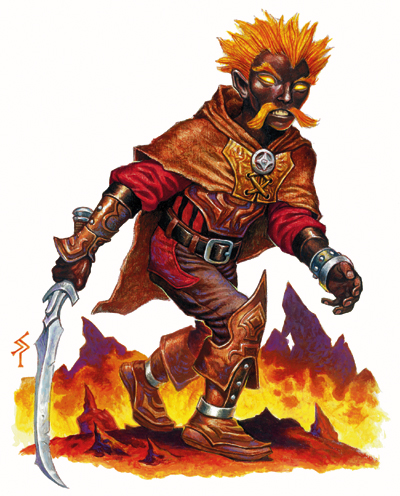
Countless ages of toil in the deep mines of Dothion, where the walls between the Twin Paradises of Bytopia and the Elemental Plane of Fire are very thin indeed, has created a hybrid race that shares some qualities of gnome and some of fire elemental. Fire gnomes are exceptionally resistant to heat and especially vulnerable to cold, and though they share some of the same interests as their cousins the svirfneblin, fire gnomes are nowhere near as insular and paranoid.
Fire gnomes do not have the innate illusion powers of their cousins, but they are capable of impressive effects with fire. They frequently give ground, only to devise elaborate schemes and return later. And also unlike rock gnomes, fire gnomes have no compunctions about killing - especially in defense of their mines and tunnels. Adept at spotting incendiaries and explosives carried by opponents, fire gnomes are all too happy to start fires (which have no effect on them, of course) in hopes of setting off an opponent's own supply of explosives - and thus letting the fire gnomes defeat their foes with only minimal effort.
FIRE GNOME RACIAL TRAITS
-
+2 Constitution, -2 Strength.
-
Humanoid (Extraplanar, Fire, Gnome): Fire gnomes are native to both the Twin Paradises of Bytopia and the Elemental Plane of Fire. They gain the extraplanar subtype when not in those Planes.
-
Small: As Small creatures, fire gnomes have a +1 bonus to Armor Class, a +1 bonus on attack rolls, and a +4 bonus on Hide checks. They use smaller weapons than Medium characters use, and their lifting and carrying limits are three-quarters of those of a Medium character.
-
A fire gnome's base land speed is 20 feet..
-
Darkvision out to 60 feet.
-
Stonecunning: This ability grants fire gnomes a +2 racial bonus on Search checks to notice unusual stonework. A fire gnome who merely comes within 10 feet of unusual stonework can make a Search check as though actively searching, and can use the Search skill to find stonework traps as a rogue can. A fire gnome can also intuit depth, sensing the approximate distance underground as naturally as a human can sense which way is up.
-
+2 bonus to caster level when casting spells or using spell-like abilities with the fire descriptor.
-
Fire Subtype: A fire gnome has immunity to fire. It has vulnerability to cold, which means it takes half again as much (+50%) damage as normal from cold, regardless of whether or not a saving throw is allowed, or if the save is a success or a failure.
-
+1 racial bonus on attack rolls against kobolds and goblin oids (including goblins, hobgoblins, and bugbears).
-
+4 dodge bonus to Armor Class against creatures of the giant type (such as ogres, trolls, and hill giants).
-
Spell-Like Abilities: 1/day - heat metal, produce flame. Caster level equals the fire gnome's character level +2 (including the caster level bonus mentioned above).
-
Automatic Languages: Common, Gnome, Ignan. Bonus Languages: Draconic, Dwarven, Elven, Giant, Goblin, Orc, Terran.
-
Favored Class: Sorcerer.
-
Level adjustment +1.
FROST DWARVES
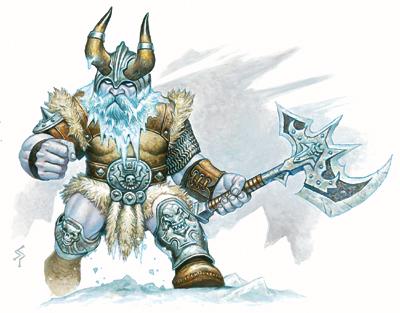
Millennia ago, the frost giants of the Ice Wastes of the Abyss enslaved a tribe of duergar and brought them to their home to craft armor and weapons. All but the hardiest perished, and those who survived gradually changed, becoming more like their frost giant masters. Now, frost dwarves toil away in the mines and forges of the Ice Wastes, plotting their liberation - and their revenge.
Like other dwarves, frost dwarves use their environment to its fullest, though they only rarely plan out their attacks in advance. Frost dwarves hurl themselves into every battle with reckless abandon, hacking away with their axes until no enemies are left. In close combat, frost dwarves sometimes cast aside their battleaxes and attempt to grapple their foes into submission, using their chill touch spell-like ability to help take the fight out of their enemies (and later ransoming their prisoners for a hefty profit). If outmatched - or if they simply wish to remain hidden - frost dwarves use their obscuring mist spell-like ability to confuse their enemies and cover their escape. (The frost dwarves may not be able to see through the mist themselves, but they know the layout of their mines and tunnels.)
FROST DWARF RACIAL TRAITS
-
+4 Constitution, -4 Charisma.
-
Humanoid (Dwarf, Extraplanar): Frost dwarves are native to the Infinite Layers of the Abyss. They gain the extraplanar subtype when not in the Abyss.
-
Medium size.
-
Darkvision out to 120 feet.
-
Immunity to paralysis, phantasms, and poison.
-
Resistance to cold 10.
-
Stability: Dwarves are exceptionally stable on their feet. A dwarf has a +4 bonus on ability checks made to resist being bull rushed or tripped when standing on the ground (but not when climbing, flying, riding, or otherwise not standing firmly on the ground).
-
+2 racial bonus on saves against spells and spell-like abilities.
-
+1 racial bonus on attack rolls and +4 dodge bonus to Armor Class against creatures of the giant type (such as ogres, trolls, and frost giants).
-
Spell-Like Abilities: 1/day - chill touch and obscuring mist as a wizard of the frost dwarf's class level +2 (minimum caster level 3rd).
-
Light sensitivity (dazzled in bright sunlight or with in the radius of a daylight spell).
-
+4 racial bonus on Move Silently checks.
-
+2 racial bonus on Appraise and Craft checks related to stone or metal.
-
Automatic Languages: Common, Dwarven, Giant. Bonus languages: Draconic, Goblin, Orc, Terran, Undercommon.
-
Favored Class: Fighter.
-
Level adjustment +1.
MEPHLINGS
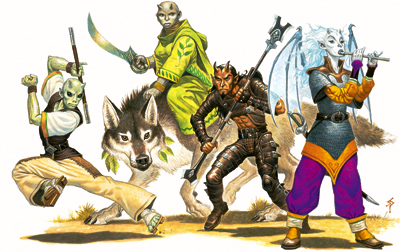
Scholarly lore contains two different origin stories for the mephlings. In one, mephlings are planetouched offshoots of long-ago unions between mephits and an indeterminate race of humanoids. The other is a darker tale of a megalomaniacal mage seeking to imprint his essence on another race.
What is true is that a mephling will occasionally be born to mephit parents. Weaker than their mephit ancestors, mephlings are put out of mephit communities as undesirable runts. They're left to the mercies of the inhospitable planes. Mephit parents revolted by their humanoid child will leave the babe on a hostile plane. Kindly parents will place the child on a habitable plane where it will easily be found by other creatures. Sometimes other creatures adopt the abandoned baby and it grows to reach adulthood.
Personality: As foundlings raised by parents very different from themselves, mephlings frequently feel out of place. They usually are loners who desire an elusive sense of belonging. Nevertheless, they're attractive and personable, generally liked by people around them.
Physical Description: Mephlings look like less comely versions of their mephit parents with stunted wings. A typical mephling stands less than 3 feet tall and weighs around 30 pounds, with females slightly taller and heavier than males.
Air: An air mephling looks like a short, cloud-white human.
Earth: An earth mephling appears akin to a short, stony, hairless dwarf.
Fire: A fire mephling resembles a miniature devil, with fiery, reddish-bronze skin.
Water: A water mephling resembles a small, fish-scaled human with black, bulbous eyes.
Mephlings do not reach adulthood until they are more than 50 years old. The longest-lived members of the race can reach an age of well over 200 years.
Relations: Mephlings fit in equally oddly in virtually all societies. At best, one is regarded as an exotic curiosity. At worst, one is seen as a friendly stranger, perhaps with a suspicious touch of devil, demon, or elemental blood - whatever is least welcome by a given culture. Mephlings get along best with others of their race who have had similar experiences. Mephlings also have good relations with halflings, especially those who have traveled widely or who frequently consort with outsiders.
Alignment: Mephlings tend to have a neutral component to their worldview, but they can be of any alignment. They frequently adopt the philosophy and worldview of their foster parents or the culture in which they were raised.
Religion: Naturally disposed to becoming sorcerers and often acutely aware of an uncaring multiverse, mephlings turn to the worship of Boccob the Uncaring, Lord of all Magics. Some instead turn to the more fatalistic philosophies of Wee Jas. Many mephlings who choose to travel extensively worship Fharlanghn.
Language: Mephlings speak the language of the society in which they are raised, almost always Common. In addition, each mephling has an elemental language that reflects his or her heritage - air mephlings speak Auran, earth mephlings speak Terran, fire mephlings speak Ignan, and water mephlings speak Aquan.
Names: A mephling typically grows up with a name given by the adopting parents, but most choose another name in adulthood.
Air: Air, Breath, Breeze, Hover, Wings.
Earth: Burrow, Earth, Rock, Stone.
Fire: Crackle, Fire, Flame, Scorch.
Water: Splash, Storm, Swish, Tsunami, Water, Waves, Wet.
Adventurers: Frequently ostracized or at least marginalized in the society of their youth, mephlings almost always feel the urge to travel and adventure. They are drawn to explore the world and the multiverse beyond their hometowns.
Air: Air mephlings tend to travel a great deal. Their favored class is bard, and they prefer wind instruments.
Earth: Earth mephlings have much of the strength of their natural element. The harmonious balance of earth leads many to pursue the favored class of druid.
Fire: The mephit heritage is very strong in fire mephlings. Their favored class is sorcerer.
Water: Calm as a still pond, strong as rushing water, a water mephling's favored class is monk.
MEPHLING RACIAL TRAITS
-
-2 Intelligence, +2 Charisma. Mephlings are generally a bit slow on the uptake, but they make up for it with strong personalities. In addition, each kind of mephling has one or more ability modifiers specific to its race.
Air: +2 Dexterity. Air mephlings are quick in action.
Earth: +2 Strength, -2 Dexterity. Earth mephlings are physically strong but slow to act.
Fire: +2 Dexterity. Like air mephlings, fire mephlings are agile and quick.
Water: +2 Constitution. Water mephlings are sturdy and durable.
-
Humanoid (Extraplanar): Mephlings are native to the Elemental Planes. They have the humanoid type and gain the extraplanar subtype when not on their respective ancestral plane. Unlike their mephit ancestors, mephlings do not have an elemental subtype.
-
Small: As Small creatures, mephlings have a +1 bonus to Armor Class, a +1 bonus on attack rolls, and a +4 bonus on Hide checks. They use smaller weapons than Medium characters use, and their lifting and carrying limits are three-quarters of those of a Medium character.
-
A mephling's base land speed is 30 feet. In addition, an air mephling has a fly speed of 10 feet (perfect), an earth mephling has a burrow speed of 10 feet, and a water mephling has a swim speed of 30 feet.
-
Each mephling has a breath weapon, the effect of which varies by the mephling's heritage. An air mephling's breath weapon is a cone of dust and grit (piercing damage), an earth mephling's breath weapon is a cone of rock shards and pebbles (bludgeoning damage), a fire mephling's breath weapon is a cone of flame (fire damage), and a water mephling's breath weapon is a cone of caustic liquid (acid damage). Regardless of the effect, a mephling's breath weapon fills a 15-foot cone, deals 1d8 points of damage to each target, and allows a Reflex save (10 + 1/2 mephling's Hit Dice + mephling's Con modifier) for half damage. A 1stlevel mephling can use his breath weapon once per day; a higher-level mephling gains one additional use per day for every four levels he has attained. If a mephling can use his breath weapon more than once per day, 1d4 rounds must pass between consecutive uses of the breath weapon.
-
Mephlings cast spells with an elemental descriptor that matches their kind (air, earth, fire, or water) at +1 caster level.
-
Automatic Languages: Mephlings speak Common and one elemental language appropriate to their kind (Aquan, Auran, Ignan, or Terran). Bonus Languages: Aquan, Auran, Ignan, Terran.
-
Favored Class: Each kind of mephling has its own favored class, reflecting its racial tendencies. The air mephling's favored class is bard, as befits its love of travel and wind instruments. The earth mephling's favored class is druid, representing its link to the earth and stone of the natural world. The fire mephling's favored class is sorcerer, reflecting its natural arcane power. The water mephling's favored class, monk, matches its calm strength and patience.
-
Level Adjustment: +1.
NERAPHIM
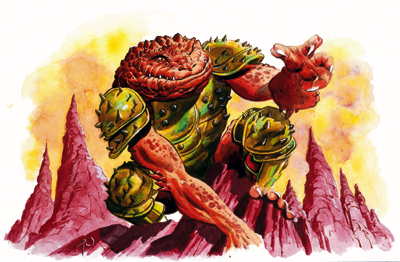
A neraph (plural neraphim) is sometimes mistaken for a slaad at a distance, due to the two races' similarity in appearance. However, neraphim and slaadi are distinct kinds of creatures, at least so far as any race can be considered distinct in the roiling chaos of the plane of Limbo.
Neraphim are a nomadic people who hunt through the maelstrom of Limbo, tracking their elusive and evermoving prey. Neraphim have developed special hunting tools and techniques, giving them exceptional skill in bringing down the game they seek above all else: the chaos beast, one of which provides a neraph tribe with a week's worth of nutrition and raw materials for clothing. They are proficient leapers, able to jump from mote to mote of stable earth in the otherwise ever-changing environment of Limbo.
For social and economic purposes, the neraphim organize themselves in houses. Each house lays claim to certain hunting grounds, giving its members access to resources within that territory. The various houses congregate once every seven years to conduct a great racial celebration known as the Festival of Spawning. During the festival, the houses negotiate with one another, exchanging resources and influence as each house seeks to better its position within the neraphim hierarchy.
Personality: Neraphim cannot afford to be as inconsistent as the plane they inhabit and the game they hunt - only stern discipline within each neraph house keeps its members from succumbing to poverty and starvation. Each house consists of a bonded group of neraphim made up of several related families and one matriarch. In the time between their Festivals of Spawning, the various neraphim houses meet only rarely, and then often in conflict over disputed hunting grounds. Alliances between houses are not uncommon, if a particular threat warrants.
Within each house, the rule of the matriarch is law, and her rule can be harsh. The most severe punishment a matriarch can dispense is exile from the house. Exiled neraphim can be encountered, though most are slain by other houses, slaadi, githzerai hunting parties, and roaming chaos beats. Some exiles have open personalities and strike up friendships with travelers from other planes, hoping to accompany them home and leave the dangerous realm of Limbo behind.
Physical Description: Neraphim are roughly humanoid in shape, with coarse red hide. Though bipedal like other humanoids, a neraph has a massive, toadlike head shaped like that of a red slaad. The range in height and weight found among neraphim is the same as found among humans. Chitinlike encrustations on a neraph's skin provides it some natural protection; however, neraphim also prefer to wear colorful bone-spiked leather (made of stabilized and cured chaos beast hide). Neraphim take longer to mature than humans do, not reaching adulthood until age 40, but they can live to be more than 400 years old.
Relations: Neraphim encountered while still associated with a house are generally unfriendly toward strangers, even those of the same race. However, exiles are more open-minded and may team up with others (whether neraphim, githzerai, or some other-planar race) in order to survive. On the other hand, because neraphim remind some individuals of smaller, skinnier red slaadi, other races are usually a bit standoffish at first.
Alignment: Even though they hold themselves above the general churn of Limbo, neraphim can't help having one chaotic component in their alignment. They try not to give in to their chaotic nature, and generally are successful in this practice.
Religion: Giving some credence to the theory that the neraphim are a subspecies of slaad, a few neraphim houses worship less bloodthirsty and less insane aspects of the entities Ssendam and Ygorl (who are normally considered to be, if not slaadi deities, at least very powerful slaadi worthy of respect).
Language: Neraphim speak their own language and Slaad. Some learn Common, which allows them to better communicate with creatures of other planes, and some learn Abyssal and Celestial.
Names: Neraphim have given names and house names. Those exiled from a house are usually ceremonially stripped of their house names, though some continue to refer to themselves as such, while others take appellations similar to "the Exile," "the Stricken," or "the Houseless."
Male Names: Anh, Cado, Hao, Sam, Tam, Teo, Thanh, Thuan, Van, Xuan.
Female Names: Chi, Hyunh, Lan, Mai, Nam, Tham, Trinh, Yen.
House Names: Spent River, Hanging Cliff, Invisible Sea, Lost Mountain, Burning Water, Living Stone.
Adventurers: With little to no prospect of returning to his or her house, and with even less prospect of joining another house, an exiled neraph makes a perfect adventurer. Exiles who embrace this path soon learn to excel, for the skills that allow them to hunt in the changing seas of Limbo are useful elsewhere. Against all odds, some exiles adventure in order to complete a great quest or meet some other condition imposed by a house matriarch that might allow them back into a house. However, once a neraph discovers the greater cosmos, he or she seldom wishes to return to a primitive and nomadic lifestyle.
NERAPH RACIAL TRAITS
-
Outsider (Extraplanar): Neraphim are native to the plane of Limbo, and thus have the outsider type. They gain the extraplanar subtype when not on Limbo. They are not subject to spells or effects that affect only humanoids, such as charm person and dominate person.
-
Medium: As Medium creatures, neraphim have no special bonuses or penalties due to their size.
-
A neraph's base land speed is 30 feet.
-
Neraphim have darkvision out to 60 feet.
-
Neraph Camouflage (Ex): When charging an opponent or when using a thrown weapon, neraphim can use a technique known as motion camouflage (also called neraph camouflage by other races), which predatory insects use to trick prey into thinking they are stationary even though they are moving closer. The target creature can be fooled into believing that the charging neraph or the neraph's thrown weapon is in fact not moving closer, or moving closer only very slowly.
A neraph can make one camouflage attack per enemy per encounter (once a foe sees the attack in action, that foe can discern it for what it is for the duration of that combat). Creatures that are subject to a neraph's charge or that are targeted by a weapon thrown by a neraph may not apply their Dexterity bonuses to their Armor Class. All conditions that pertain when a foe cannot apply his Dexterity bonus to Armor Class also pertain to the neraph's attack (for instance, a sneak attack could also be made with this attack, if the neraph can make such an attack).
-
Leap (Ex): Neraphim are natural jumpers. They have a +5 racial bonus on Jump checks.
-
Weapon Familiarity: Neraphim may treat the annulat as a martial weapon rather than an exotic weapon.
-
+2 Natural Armor: Natural skin encrustations grant neraphim some protection against harm.
-
Skills: Neraphim have a +2 racial bonus on Spot and Search checks.
-
Automatic Languages: Neraph, Slaad. Bonus Languages: Common, Celestial, Abyssal.
-
Favored Class: Ranger.
SHADOWSWYFTS
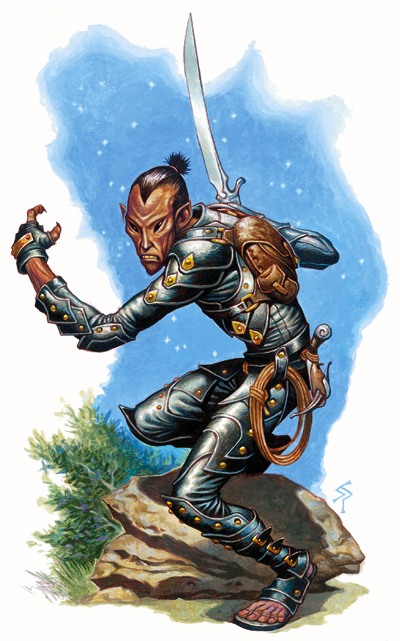
Shadowswyfts are planetouched beings with ancestry from the Plane of Shadow.
Personality: Shadowswyfts are mercurial in temperament. They delight in action and in acting now. Delay or inactivity irritates shadowswyfts. In the amount of time it takes to formulate and evaluate a plan, worlds could be won or lost.
Physical Description: Shadowswyfts little resemble other races. Tall and slender, they have skin ranging in hue from medium brown to lustrous black and almost completely black, slanted eyes. Their dark coloring and light build make them very adept at hiding in shadows and moving quietly. The average male shadowswyft stands more than 6 feet tall and weighs about 165 pounds, with females somewhat shorter and lighter. Shadowswyfts reach adulthood at about the same age as a half-orc, but it's rare for a shadowswyft to live beyond age 60.
Relations: To a shadowswyft, one's actions are much more important than one's species. Shadowswyfts will associate with chaotic creatures of all kinds. These alliances rarely last long, but they usually end amicably with the shadowswyft moving on to journey with other people in far-flung places.
Alignment: Shadowswyfts tend to be chaotic. Their generally short attention span and love of action without thought for its consequences is incompatible with lawful philosophies.
Religion: The most common religion among the shadowswyfts is the worship of Olidammara, the god of rogues. Shadowswyfts who do not worship the Laughing Rogue generally choose to travel and adventure, and they favor Fharlanghn or Boccob.
Language: Since shadowswyfts can see very well in low light and in darkness, their language utilizes sound and kinesics (body language including body movements, position, and facial expressions). To convey the full extent of meaning in written works, a variety of symbols are used. It's not unusual for a single word to be accompanied by three or four symbols to help show its connotations and subtleties.
Names: Shadowswyft names tend to be short, usually monosyllabic, and accompanied by a signifying gesture. When a name is accurately translated into another language, it becomes a much longer sobriquet that shadowswyfts are apt to shorten.
Male Names: Bhear, Bhah, Brot, Flah, Flaht, Fraa, Pohl, Phaer, Prag.
Female Names: Gheer, Gree, Graf, Grif, Mhi, Mheer, Mrak, Tap, T'Har.
Signifying Gesture: Blink, bow, nod, lower hands, point left index finger, point right index finger, raise hands, shake head, shrug, touch chin, or wink.
Adventurers: Adventure attracts shadow swyfts as a candle does moths. Most feel the pull to adventuring careers. They relish the variety and diversity of activity. An adventuring life is one filled with action and change, and thus is well suited to the shadowswyft's temperament.
SHADOWSWYFT RACIAL TRAITS
-
+2 Dexterity, -2 Constitution. Shadowswyfts are limber, but not very healthy.
-
Outsider (Extraplanar): Shadowswyfts are native to the Plane of Shadow, and thus have the outsider type. They gain the extraplanar subtype when not on the Plane of Shadow. They are not subject to spells or effects that affect only humanoids, such as charm person and dominate person.
-
Medium: As Medium creatures, shadowswyfts have no special bonuses or penalties due to their size.
-
A shadowswyft's base land speed is 40 feet.
-
Shadowswyfts have darkvision out to 120 feet and lowlight vision.
-
Light Blindness (Ex): Abrupt exposure to bright light (such as sunlight or a daylight spell) blinds a shadowswyft for 1 round. On subsequent rounds, it is dazzled as long as it remains in the affected area.
-
+2 bonus on initiative checks: Shadowswyfts have quick reactions.
-
Skills: Shadowswyfts have a +4 racial bonus on Hide and Move Silently checks.
-
Automatic Languages: Shadowswyft, Common. Bonus Languages: Abyssal, Celestial, Elven.
-
Favored Class: Rogue.
-
Level Adjustment: +1.
SPIKERS
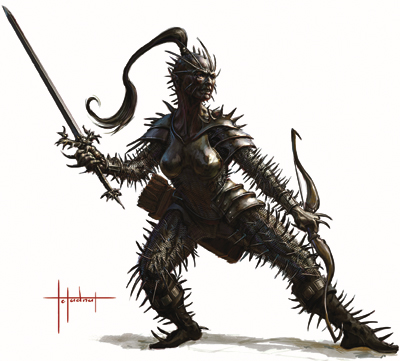
Spikers are of the same general ancestry as bladelings. Both races hail from Acheron, but scholarly speculation places their origins on the Nine Hells of Baator, the Bleak Eternity of Gehenna, or even some unknown metal-based plane.
Personality: Spikers, like bladelings, share a great love of battle. They bravely enter combat, often focusing their attacks on the most dangerous opponent they perceive.
Physical Description: The skin of a spiker is of a dull metallic hue, spotted with patches of metallic spines. A spiker's eyes are a deep violet, and its blood is black and oily. Spikers are about as tall as humans but are considerably heavier, with the average male weighing over 200 pounds and the average female about 40 pounds lighter. Spikers don't reach adulthood until past the age of 30, and even the longestlived among the race don't survive to see the end of their ninth decade.
Relations: Spikers are conservative about trusting other races, and they tend to be very cautious around anyone other than fellow spikers and bladelings.
Alignment: Spikers tend toward lawful alignments, gravitating toward lawful neutral or lawful evil. Lawful good and nonlawful spikers are uncommon, but not unheard of, though such characters usually choose to leave Acheron to travel the planes.
Religion: Hextor's emphasis on law and war appeals to most spikers. Sometimes the sheer joy of battle fosters an affinity for Kord, and many spikers who worship the god of strength choose to be barbarians.
Language: Spikers speak Common. Many also learn Infernal.
Names: Spiker names tend toward visceral or combat-oriented words, with no gender differentiation. A spiker's first name is usually a simple one (often a weapon or a combat-focused verb) given at birth. The second name is usually a nickname earned in adolescence or adulthood.
First Names: Dirk, Grip, Parry, Rend, Spike, Thrust.
Second Names: Bloodletter, Demonbane, Falldown, Fartraveler, Gutrender, Spellfodder.
Adventurers: Spikers love combat. The best way to test one's bravery and skill is through serious, no-punches-pulled fighting. Thus, the adventuring life offers ideal opportunities for a spiker to test her mettle. Also, spikers who do not have a lawful neutral or lawful evil worldview find themselves misfits in the spiker society on Acheron.
SPIKER RACIAL TRAITS
-
Humanoid (Extraplanar): Spikers are humanoids native to Acheron. They gain the extraplanar subtype when not on Acheron.
-
Medium: As Medium creatures, spikers have no special bonuses or penalties due to their size.
-
A spiker's base land speed is 30 feet.
-
Spikers have darkvision out to 60 feet.
-
Natural Armor: A spiker's metallic hide offers protection from physical attacks in the form of a +1 bonus to natural armor.
-
Damage reduction 2/piercing or slashing: A spiker's spiny skin grants resistance to bludgeoning attacks, though piercing or slashing attacks slip through normally.
-
Resistance to acid 5: Despite the metallic hue of their hide, spikers are not metallic in nature and suffer no special effect from rusting attacks and the like.
-
Weapon Proficiency: Spikers receive the Martial Weapon Proficiency feat for armor spikes as a bonus feat. This allows them to use their natural spiked skin as a weapon without penalty (see below).
-
Natural Spikes (Ex): A spiker's skin is replete with sharp, jagged spikes. A spiker can deal extra piercing damage on a successful grapple check, or deal piercing damage with a melee attack, as if she wore armor spikes. Because of their spiked skin, spikers have a difficult time wearing armor. The maximum Dexterity bonus of the armor is reduced by 1, and the armor check penalty is worsened by 2. For instance, a chain shirt worn by a spiker has a maximum Dexterity bonus of +3 (instead of +4) and an armor check penalty of -4 (rather than -2). These changes don't affect the armor's arcane spell failure chance, nor do they apply to shields used by the spiker.
-
Automatic Language: Common. Bonus Language: Infernal.
-
Favored Class: Fighter.
TIEFLINGS
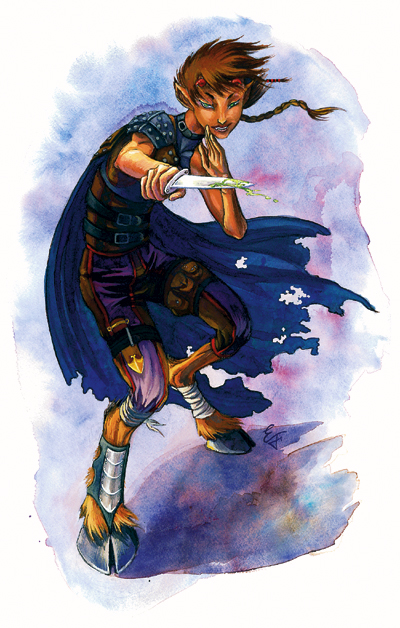
Carrying the taint of evil in their forms - and perhaps their very souls - tieflings are often persecuted and feared throughout the planes. The distant descendants of humans and evil outsiders, tieflings are regarded as twisted, devious, and untrustworthy. More often than not, this opinion is accurate.
Personality: Tieflings live as outcasts from an early age - as soon as their heritage shows itself - which contributes to their bitter outlook on life. Tieflings learn to keep others at a distance, often compensating for their loss with cruelty or depravity.
Physical Description: Tieflings look human (and are roughly the same height and weight as members of that race), except for one or two distinguishing features related to their unusual ancestry. Some examples of these features include small horns, pointed teeth, red eyes, a whiff of brimstone about them, cloven feet, or red skin. No two tieflings look alike. Tieflings reach adulthood at about the same age as humans but are longer-lived, with the eldest members of the race living to be 150 years old.
Relations: Tieflings treat most other races equally - at arm's length. They are very slow to trust others and always wary of a friend suddenly becoming an enemy. Aasimars, bariaurs, and wildren often trigger an instinctive fear or revulsion in tieflings, making it difficult for them to work together at all. Tieflings respect other mixed-breed races that have to put up with persecution and derision, including half-orcs and mephlings. Still, a tiefling isn't more likely to trust a member of one of these races; she's just more likely to understand their perspective.
Alignment: Tieflings tend toward evil alignments, though neutral tieflings are not uncommon. Those who choose a life of good - and manage to stick to it - are particularly rare.
Religion: Tieflings have no common deity. Most choose to worship evil deities such as Erythnul, god of slaughter; Vecna, god of secrets; or Hextor, god of tyranny. Neutral tief lings may venerate Wee Jas, goddess of death and magic, or Olidammara, god of thieves. Still others choose to pay homage to archfiends whose names are best not mentioned.
Language: Tieflings share no common language. Some learn Infernal or Abyssal, although since most have no idea where their bloodline comes from, as often as not they choose the wrong racial language. A tiefling usually learns the language of her parents as well.
Names: As a rule, tieflings use human names until such time as they seek to differentiate themselves from their parents. At that point, they often take names that hint at their fiendish heritage. Some choose words of Infernal or Abyssal that sound menacing, occasionally without even knowing the words' definitions.
Adventurers: As natural outcasts, tieflings often follow a life of adventure and intrigue. Those that hew to their heritage become thieves, brigands, or killers. Some tieflings reject their tainted blood and seek the light, aiming to help those in need.
TIEFLING RACIAL TRAITS
-
+2 Dexterity, +2 Intelligence, -2 Charisma.
-
Outsider (Native): Tieflings are outsiders native to the Material Plane, and thus have the outsider (native) type. They gain the extraplanar subtype when not on the Material Plane. They are not subject to spells or effects that affect only humanoids, such as charm person and dominate person.
-
Medium: As Medium creatures, tieflings have no special bonuses or penalties due to their size.
-
A tiefling's base land speed is 30 feet.
-
Tieflings have darkvision out to 60 feet.
-
Skills: Tieflings have a +2 racial bonus on Bluff and Hide checks.
-
Darkness (Sp): A tiefling can use darkness, as the spell, once per day. Her caster level is equal to her character level.
-
Resistance to cold 5, electricity 5, and fire 5: Tieflings share some of their fiendish ancestors' resistance to energy damage.
-
Automatic Languages: Common, Infernal. Bonus Languages: Draconic, Dwarven, Elven, Gnome, Goblin, Halfling, Orc.
-
Favored Class: Rogue.
-
Level Adjustment: +1.
WILDREN
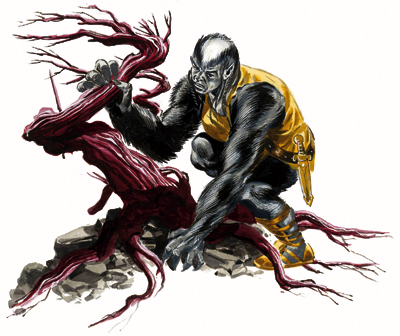
Over time, the petitioners (spirits of the departed) who arrive in the Wilderness of the Beastlands acquire animal traits, eventually becoming celestial beasts or animals. Some instead mingle with the beasts they will one day become, creating new races that are perpetually half-animal, half-humanoid. Prominent among these are the wildren, beings descended from the union of partially transformed dwarf petitioners and celestial badgers.
Prowling the darkest forests of Karasuthra, the Beastlands' lowest layer, wildren build elaborate underground burrows, which they defend, out of a commingled racial memory, to the death. Often short-tempered and vengeful, wildren generally live solitary lives, emerging only occasionally from their burrows to hunt and seek mates.
Personality: Wildren are edgy and easily riled, though loyal to those who befriend them and, on rare occasions, even playful (especially toward their young). They are most savage and feral when on the defensive, though they are still quite formidable on the attack.
Physical Description: The typical wildren looks like a dwarf covered in short, grizzled dark fur, with a broad white stripe of fur running from the bridge of the nose over the top of the head and down to the base of the skull. A wildren's arms are unnaturally large and well-muscled, and her fingers end in hard claws 2 to 3 inches long. Wildren constantly emit a fetid odor. On average, wildren are slightly taller and slightly lighter than dwarves. They reach adulthood at the same age as dwarves but mature more rapidly thereafter. It's possible for a wildren to live for more than 500 years, but the race's average life span is about 200 years shorter than that.
Relations: Most wildren spend their lives hunting in the perpetual night of Karasuthra. After a mating pair has raised a child to adulthood, they drive it from the burrow, forcing it to seek its own fortune. These wildren usually dig their own burrows far from their birthplace, but some never settle down, moving from layer to layer of the Beastlands in search of a new "family." They come to see life as one long hunting expedition and can travel far afield in search of adventure. They are most comfortable on planes where wildlife is abundant, especially if the ground lends itself to the creation of a burrow. Though the average wildren finds beings of other races strange and threatening, adventuring wildren generally feel that way only toward the evil races. Wildren of any kind are most uncomfortable in cities, though they can cope if provided with a burrowlike place to sleep.
Alignment: The average wildren is chaotic good, tending toward neutral good. A few are neutral or chaotic neutral. Religion: Most wildren pay homage to Ehlonna, not necessarily in the form of actual worship but more as a show of respect for the most dangerous animal in their immediate environment. Wildren rarely become clerics, but some are happy as druids.
Language: The wildren language is actually an amalgam of Common, Dwarven, and badger growling. It is not truly a separate tongue, but rather a convenient medium for members of a race who share the same three languages.
Names: Wildren usually have only a spoken name, other wise recognizing one another by scent. (They often see nonwildren in the same light and are confused by individuals with more than one name - and even more confused by individuals who wear perfume or cologne.)
Male Names: Arl, Brum, Durrl, Grunnur, Morrm, Nall, Vruk.
Female Names: Brayarr, Dierrel, Hugk, Mrall, Purruk, Vap.
Adventurers: Only unsettled wildren become adventurers. Without a home, but missing the camaraderie of family, they join up with other homeless (in other words, adventuring) characters to relive some of that experience.
WILDREN RACIAL TRAITS
-
+4 Constitution, -2 Dexterity, -2 Charisma. Wildren are extremely durable, but they are slow to react and have a reserved personality.
-
Outsider (Extraplanar): Wildren are native to the Wilderness of the Beastlands, and thus have the outsider type. They gain the extraplanar subtype when not in the Beastlands. They are not subject to spells or effects that affect only humanoids, such as charm person and dominate person.
-
Medium: As Medium creatures, wildren have no special bonuses or penalties due to their size.
-
A wildren's base land speed is 20 feet. She can move at this speed even when wearing medium or heavy armor or when carrying a medium or heavy load (unlike other creatures, whose speed is reduced in such situations).
-
Wildren have a burrow speed of 10 feet. In soil or loose dirt, a wildren can build a warren large enough for one Medium creature in the space of 1 hour.
-
Wildren have darkvision out to 60 feet.
-
Wildren have the scent ability.
-
Wildren have two primary claw attacks that are natural weapons, dealing points of damage equal to 1d4 + the wildren's Str bonus.
-
Fury (Ex): Once per day, a wildren who has taken at least 1 point of damage can choose to enter a brief state of ragelike fury at the beginning of her next turn. In this state, a wildren gains +4 to Strength and -2 to Armor Class. The fury lasts for 1 round, and a wildren cannot end her fury voluntarily. The effect of this ability stacks with similar effects (such as the barbarian's rage class feature).
-
Stability (Ex): Wildren are exceptionally stable on their feet. A wildren has a +4 bonus on ability checks made to resist being bull rushed or tripped when standing on the ground (but not when climbing, flying, riding, or otherwise not standing firmly on the ground).
-
Automatic Languages: Wildren speak Common and Dwarven, and are able to communicate with badgers as though under the effect of a speak with animals spell that affects only badgers. Bonus Languages: Sylvan, Gnome, Goblin, Orc, Terran.
-
Favored Class: Barbarian.
-
Level Adjustment: +1.